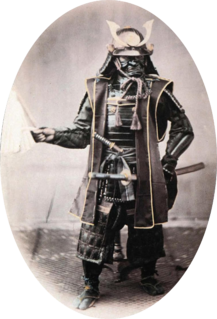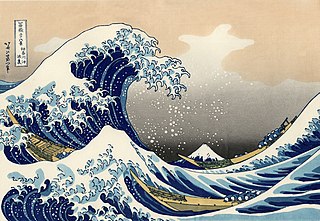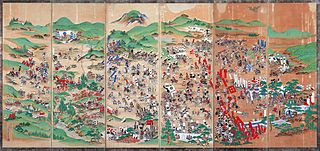This article does not cite any sources .(March 2007) (Learn how and when to remove this template message) |
This article needs additional citations for verification .(July 2007) (Learn how and when to remove this template message) |
Yamada Arinaga(山田 有栄) (1578–1668) was a Japanese samurai of the Azuchi-Momoyama period through the early Edo period, who served the Shimazu clan of Satsuma. He was the eldest son of Yamada Arinobu.

Samurai (侍) were the military nobility and officer caste of medieval and early-modern Japan.

The Edo period or Tokugawa period (徳川時代) is the period between 1603 and 1868 in the history of Japan, when Japanese society was under the rule of the Tokugawa shogunate and the country's 300 regional daimyō. The period was characterized by economic growth, strict social order, isolationist foreign policies, a stable population, "no more wars", and popular enjoyment of arts and culture. The shogunate was officially established in Edo on March 24, 1603, by Tokugawa Ieyasu. The period came to an end with the Meiji Restoration on May 3, 1868, after the fall of Edo.

The Shimazu clan were the daimyō of the Satsuma han, which spread over Satsuma, Ōsumi and Hyūga provinces in Japan.
On 1587 after his father surrendered to Toyotomi Hidenaga at Taka Castle, he was given over as a hostage to Hidenaga. He then fought as a retainer for the Shimazu clan during the Seven-Year War and the 1600 battle of Sekigahara. He also had killed Ijuin Tadazane, a fellow Shimazu retainer, to put down a potential rebellion. He was considered an important retainer and became a Karō, a samurai official/adviser. During peacetime, Yamada took up the teaching of retainers as well as developing industries.
Yamada Arinobu was a retainer of the Shimazu clan during the Edo period. He served under Shimazu Takahisa and then under Shimazu Yoshihisa. On 1568, he became a Karō for his services.

Toyotomi Hidenaga, formerly known as Hashiba Koichirō.

The Battle of Sekigahara was a decisive battle on October 21, 1600, that preceded the establishment of the Tokugawa shogunate.
Yamada served in the shogunate army at the 1637-38 Shimabara Rebellion, a revolt involving mostly Japanese peasants, most of them Catholics.

The Shimabara Rebellion was an uprising in what is now Nagasaki Prefecture in southwestern Japan lasting from December 17, 1637, to April 15, 1638, during the Edo period. It largely involved peasants, most of them Catholics.
![Shimazu Yoshihiro [島津義弘] samurai of the Sengoku period](https://upload.wikimedia.org/wikipedia/commons/thumb/4/4b/Shimazu_Yoshihiro.jpg/320px-Shimazu_Yoshihiro.jpg)


![Tachibana clan (samurai) [立花氏] samurai clan](https://upload.wikimedia.org/wikipedia/commons/thumb/b/b1/Gion_Mamori.svg/316px-Gion_Mamori.svg.png)


